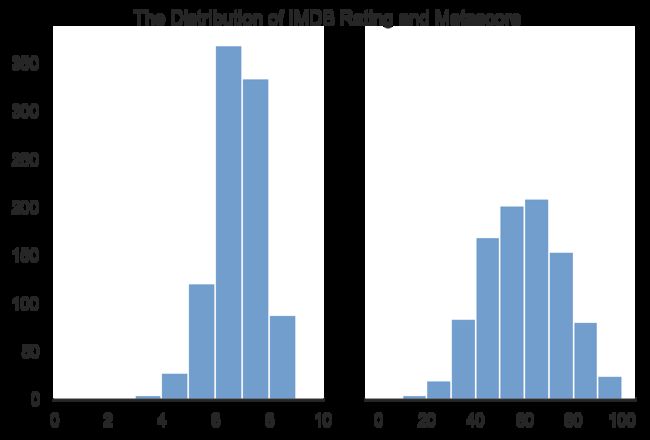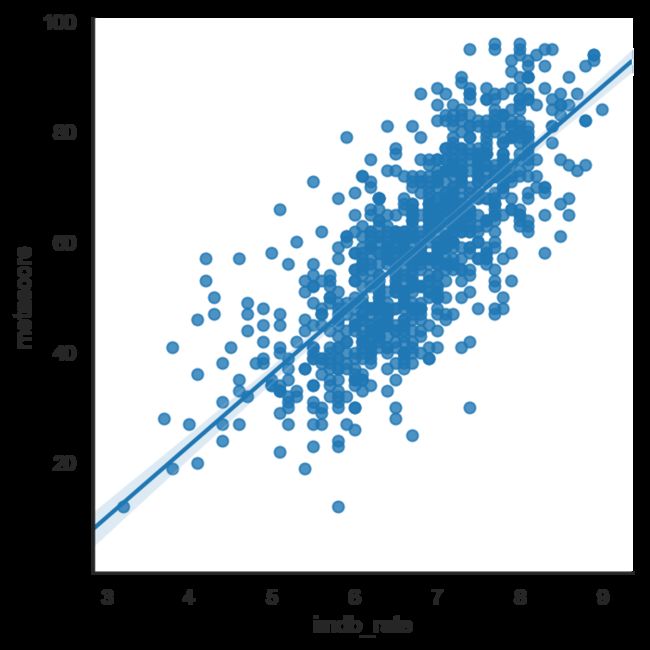之前利用Python的request和BeautifulSoup工具包爬取了IMDB网站上美国电影票房历史排名前1000的电影数据,本文以此数据为基础,作相关的数据分析。分析步骤大致与猴子哥live中介绍的方法一致:分为提出问题--理解数据--数据清洗--数据可视化。猴子哥live中有一步是构建模型,我把这部分融合到了数据可视化环节中。
1. 提出问题
本文使用的数据是IMDB美国票房排名前1000的电影数据,数据包含了电影名称,票房金额,上映年份,演职人员,IMDB评分,电影类型等信息,数据中的很多电影大家也比较熟悉。
相信不少人都有这样的经历,当想要看一部电影的时候,会去百度一下谁是导演,谁是主演。如果导演是克里斯托弗·诺兰,心里已经给电影打了个8分以上的评分了。而阿汤哥的动作片,预期也都能肾上腺素飙升。对于已上映的电影,不少人会去豆瓣搜索现时的评分,或是前作的评价,若是豆瓣高分、高评论数,也会按奈不住去蹭下热度。如果要去电影院观看的话,想必不少人会更倾向选择动作片或者科幻大片这类特效丰富,影音冲击强烈的电影。近几年特效技术和3D动画的日渐成熟,影院观影已经是越来越多人的第一选择。所以结合以上信息,可以针对IMDB电影数据提出以下问题:
- 电影年份的分布如何?近几年特效丰富的电影(以动作片、动画片为主)是否在更加流行?
- 电影类型的分布如何?哪类电影的平均分较高?
- 动作片或者科幻片等特效丰富的电影比例是否更高?
- 电影时长的分布如何?时长是否和评分有相关性?
- IMDB评分是否和票房有相关性?
- 哪些导演的电影更受观众喜爱?
- 哪些演员的电影总票房更高?
2. 理解数据
数据分析的第二部分是理解数据,这里要先读取数据并查看数据的内容,了解数据的组成和包含的信息。根据数据的内容和类型,考虑下一步的数据清洗,例如删除重复项,填充缺失值等。
# 导入相关模块
import pandas as pd
import numpy as np
# 读取存储的csv文件
df = pd.read_csv('us_box_top1000.csv')
# 查看数据的行列数
df.shape
# 计算重复行数据
sum(df.duplicated())
读取的数据有1000行,13列,没有重复行。由于爬取的是美国历史票房排名前1000的电影数据,目前来看数据符合预期。
# 查看数据的列标题
df.columns
Index(['rank', 'title', 'year', 'certificate', 'runtime', 'genre', 'imdb_rate',
'metascore', 'votes', 'gross', 'director', 'stars', 'intro'],
dtype='object')
对比IMDB网页内容,列标题基本上涵盖了每部电影的完整信息。
[图片上传失败...(image-fa0757-1538492803170)]
# 查看更多的列信息和每列数据类型
df.info()
RangeIndex: 1000 entries, 0 to 999
Data columns (total 13 columns):
rank 1000 non-null object
title 1000 non-null object
year 1000 non-null object
certificate 1000 non-null object
runtime 1000 non-null object
genre 1000 non-null object
imdb_rate 1000 non-null float64
metascore 981 non-null float64
votes 1000 non-null object
gross 1000 non-null object
director 1000 non-null object
stars 1000 non-null object
intro 1000 non-null object
dtypes: float64(2), object(11)
memory usage: 101.6+ KB
可见数据相对完整,只有一列存在19个缺失值,即metascore。根据谷歌的信息,可以知道imdb上的metascore来源于网站Metacritic,是根据专业媒体人士的评论生成的得分,更多信息可以参考这里:链接
# 查看数据的统计信息
df.describe()
- 由于只有
imdb_rate评分和metascore评分两列数据是numeric型的,所以df.describe()只显示这两列的统计信息。如果要显示所有列的统计信息,可以使用df.describe(include='all')。 - 对比10分制的imdb评分和100分制的metascore评分,可见imdb评分相对波动范围较小,最高分9.2分,最低分3.2分,而metascore评分最高分100分,最低分低至12分。之后可以使用直方图比较二者的评分分布情况。
# 查看前5行数据
df.head()
- 前5行数据对应美国票房最高的5部电影,首位的是《星球大战:原力觉醒》,第二位是《阿凡达》,第三名出人意料地被今年上映的漫威电影《黑豹》拿下,力压排在第四位的漫威同门大作《复仇者联盟:无限战争》,第五名是家喻户晓的经典爱情电影《泰坦尼克号》。
- 根据显示的信息,可以知道13列数据对应的数据信息。分别是rank: 票房排名,title: 电影名,year: 上映年份,certificate: 电影分级,runtime: 电影时长,genre: 电影类型,imdb_rate: imdb评分,metascore: metascore评分,votes: 投票人数,gross: 票房,director: 导演,stars: 主演明星,intro: 简介。
- 部分数据列需要清洗并转换数据类型。
rank列的数据是排名数据,都应该是整数,清洗时需要删掉整数后面多余的点号”.“并转换成int类型。year年份,runtime电影时长(分钟数)和votes投票人数也应该转换成整数。gross票房数据带美金符号和字母M,含两位小数,清洗后需要转换成float类型。genre电影类型和intro简介两列数据开头含有冗余的\n,需要删除。 -
genre电影类型和stars主演明星含有多个值,director导演数据可能也存在有两个或以上导演名的情况,后面需要考虑做适当处理。
3. 数据清洗
根据上述分析,按照列标题顺序对数据进行清洗,每一步都使用df[col_name].head()或者其他合适的方法检查清洗后的数据。
# 清洗rank列,删除多余的”.“号并转换成int类型
df['rank'] = df['rank'].str.replace('.', '').astype(int)
此时报错:ValueError: invalid literal for int() with base 10: '1,000',原因是1,000中含有千位符,无法转换成int类型,需要把千位符删除。修改代码如下:
# 使用两次str.replace()
df['rank'] = df['rank'].str.replace('.', '').str.replace(',', '').astype(int)
df['rank'].head()
# 检查year列数据的唯一值
df['year'].unique()
array(['(2015)', '(2009)', '(2018)', '(1997)', '(2012)', '(2017)',
'(2008)', '(2016)', '(1999)', '(2004)', '(1982)', '(2013)',
'(2006)', '(2010)', '(2002)', '(1993)', '(I) (2013)', '(2011)',
'(2003)', '(2005)', '(I) (2015)', '(2014)', '(2007)', '(I) (2010)',
'(1994)', '(I) (2017)', '(1977)', '(2001)', '(1983)', '(1996)',
'(1980)', '(1990)', '(2000)', '(1975)', '(1989)', '(I) (2016)',
'(1981)', '(1984)', '(1973)', '(1991)', '(1992)', '(1998)',
'(1985)', '(1939)', '(1995)', '(I) (2008)', '(1978)', '(1937)',
'(1986)', '(I) (2005)', '(II) (2015)', '(I) (1995)', '(1988)',
'(I) (2011)', '(1987)', '(I) (2009)', '(1965)', '(I) (2014)',
'(1961)', '(1967)', '(IX) (2016)', '(I) (1998)', '(1972)',
'(I) (2012)', '(1974)', '(1976)', '(1970)', '(1979)', '(1942)',
'(1969)', '(1964)', '(II) (2016)', '(1971)', '(1956)', '(1955)',
'(1953)', '(III) (2015)', '(1950)', '(1940)', '(I) (1999)'],
dtype=object)
年份数据很乱,不少年份信息前面还含有冗余字符,例如(III)等。通过观察可发现,年份的四位数字出现在倒数第五个字符至倒数第二个字符,可以通过str[:]方法选取这四位字符再转换成int类型。此外,榜单中有不少电影年代久远,考虑到数据可比性,只保留1980年以后的电影。
# 清洗year列,使用str[:]选取年份数字并转换成int类型,使用df.unique()方法检查数据
df['year'] = df['year'].str[-5:-1].astype(int)
df['year'].unique()
array([2015, 2009, 2018, 1997, 2012, 2017, 2008, 2016, 1999, 2004, 1982,
2013, 2006, 2010, 2002, 1993, 2011, 2003, 2005, 2014, 2007, 1994,
1977, 2001, 1983, 1996, 1980, 1990, 2000, 1975, 1989, 1981, 1984,
1973, 1991, 1992, 1998, 1985, 1939, 1995, 1978, 1937, 1986, 1988,
1987, 1965, 1961, 1967, 1972, 1974, 1976, 1970, 1979, 1942, 1969,
1964, 1971, 1956, 1955, 1953, 1950, 1940])
# 保留1980年以后的电影
df = df[df['year'] >= 1980]
# 检查certificate列,查看数据分布
df['certificate'].value_counts()
PG-13 429
PG 239
R 233
G 46
Name: certificate, dtype: int64
结合维基百科--美国电影分级制度可知,PG-13, PG, R, G都是现有的电影分级符号。
# 清洗runtime电影时长列数据,可使用str.split()方法
df['runtime'] = df['runtime'].str.split(' ').str.get(0).astype(int)
df['runtime'].head()
0 136
1 162
2 134
3 149
4 194
Name: runtime, dtype: int64
# 清洗genre电影类型数据,去掉前面的'\n'和可能存在的空格
df['genre'] = df['genre'].str.replace('\n', '').str.strip()
df['genre'].head()
0 Action, Adventure, Fantasy
1 Action, Adventure, Fantasy
2 Action, Adventure, Sci-Fi
3 Action, Adventure, Fantasy
4 Drama, Romance
Name: genre, dtype: object
每个的电影类型数据含有多个值,这里可以通过分析电影内容来判断电影类型,选取一个值作为电影的主题。先查看票房前20的电影信息。
df.head(20)
根据前20行电影数据,genre列的数据中,每部电影都有两个或三个电影类型,第一个电影类型最符合电影的内容。所以选取第一个电影类型作为电影的首要类型。
df['main_genre'] = df['genre'].str.split(', ').str.get(0)
df['main_genre'].head()
0 Action
1 Action
2 Action
3 Action
4 Drama
Name: main_genre, dtype: object
# 清洗votes投票人数数据,去掉千分位符号并转换成int类型
df['votes'] = df['votes'].str.replace(',', '').astype(int)
df['votes'].head()
0 753597
1 1001946
2 389075
3 484431
4 909482
Name: votes, dtype: int64
# 清洗gross票房金额数据,删除美金符号$和结尾的M,并转换成float类型
df['gross'] = df['gross'].str.replace('$', '').str.replace('M', '').astype(float)
df['gross'].head()
0 936.66
1 760.51
2 700.06
3 678.82
4 659.33
Name: gross, dtype: float64
# 清洗intro电影简介列,删除前面的'\n'和可能存在的字符串两侧的空格
df['intro'] = df['intro'].str.replace('\n', '').str.strip()
df['intro'].head()
0 Three decades after the Empire's defeat, a new...
1 A paraplegic marine dispatched to the moon Pan...
2 T'Challa, heir to the hidden but advanced king...
3 The Avengers and their allies must be willing ...
4 A seventeen-year-old aristocrat falls in love ...
Name: intro, dtype: object
初步的清洗工作完毕,使用df.info()和df.head()确认数据清洗后的效果。
df.info()
Int64Index: 947 entries, 0 to 999
Data columns (total 14 columns):
rank 947 non-null int64
title 947 non-null object
year 947 non-null int64
certificate 947 non-null object
runtime 947 non-null int64
genre 947 non-null object
imdb_rate 947 non-null float64
metascore 940 non-null float64
votes 947 non-null int64
gross 947 non-null float64
director 947 non-null object
stars 947 non-null object
intro 947 non-null object
main_genre 947 non-null object
dtypes: float64(3), int64(4), object(7)
memory usage: 111.0+ KB
df.head()
清洗后的数据看起来不错!由于在数据清洗中,去掉了部分列数中包含的数据单位信息,例如电影时长的单位'min',因此可以通过修改列标题将单位信息添加到列标题上,方便读者理解数据。
# 重命名部分列标题
df.rename(columns={'runtime': 'runtime_min', 'gross': 'gross_million_dollar'}, inplace=True)
df.columns
Index(['rank', 'title', 'year', 'certificate', 'runtime_min', 'genre',
'imdb_rate', 'metascore', 'votes', 'gross_million_dollar', 'director',
'stars', 'intro', 'main_genre'],
dtype='object')
由于df['metascore']列存在部分缺失值,首先查看缺失值的行数据再决定处理方法。
# 查看缺失值所在的行
condition = df['metascore'].isnull()
df[condition]
这些电影大部分是票房相对低的电影,所以舍弃这部分的电影。
# 只保留含有metascore得分的电影
df = df[df['metascore'].notnull()]
4. 数据可视化
根据第一部分提出的问题,探索数据并进行数据可视化。数据建模部分包含在这个模块。
4.1 电影年份的分布
4.1.1 电影数量在不同年份的分布
# 导入并设置数据可视化相关模块
import matplotlib.pyplot as plt
import seaborn as sns
%config InlineBackend.figure_format = 'retina'
%matplotlib inline
sns.set(color_codes=True)
sns.set_style('white')
sns.set_palette('tab20')
# 根据电影年份数据作直方图
fig, ax = plt.subplots()
df['year'].hist(range=(1980,2020), bins=40, color=(114/255,158/255,206/255))
ax.set_title('The Year Distribution of US Top Box Office Movies')
# 只保留底部坐标轴
ax.spines['top'].set_visible(False)
ax.spines['left'].set_visible(False)
ax.spines['right'].set_visible(False)
# 设定xy轴标签和网格,方便阅读数据
ax.set_yticklabels([0, 10, 20, 30, 40, 50])
ax.set_xticklabels(np.arange(1975, 2025, 5))
ax.grid(alpha=0.5)
数据显示总体上每年的高票房电影呈现逐渐增多的趋势,以每个9到10年为范围,则呈现阶梯上升的趋势。1998年起至2003年,高票房电影数量快速增加,此后基本保持在每年30部以上高票房电影的水平(不考虑不是完整年份的2018年)。
4.1.2 不同电影类型的年份累计分析
# 统计不同年份、不同类型电影的数量
cumsum = df.groupby(['main_genre', 'year']).title.count()
# 使用累加功能统计1980年起不同年份不同电影类型的累计数量,对于中间出现的缺失值,使用前值填充
genre_cumsum = cumsum.unstack(level=0).cumsum().ffill()
# 只选取总数量大于50的电影类型数据
genre_cumsum = genre_cumsum.loc[:,genre_cumsum.iloc[-1,:] >= 50]
# 根据电影类型统计数据作图
fig, ax2 = plt.subplots(figsize=(12,6))
genre_cumsum.plot(ax=ax12, legend=False, linewidth=3)
# 添加数据标签
for i in last_row.iteritems():
if i[0] == 'Adventure' or i[0] == 'Biography' or i[0] == 'Horror':
ax2.annotate('{} {}'.format(int(i[1]), i[0]), xy=(2018.5, i[1]-5), fontsize=12)
else:
ax2.annotate('{} {}'.format(int(i[1]), i[0]), xy=(2018.5, i[1]+5), fontsize=12)
# 美化图表
ax2.set_title('The Aggregate Movies of Different Genres Over Years', fontsize=16)
ax2.spines['top'].set_visible(False)
ax2.spines['right'].set_visible(False)
ax2.spines['left'].set_visible(False)
ax2.tick_params(bottom=True, labelleft=False)
ax2.set_xlabel('')
plt.tight_layout()
从上图可见,前五大电影类型分别是动作片Action,喜剧片Comedy,动画片Animation,剧情片Drama,冒险片Adventure。1995年之前,动作片和喜剧片都是影院观众最喜爱的电影类型,对应的高票房数量不分伯仲,剧情片是另一相对流行的电影类型。1995年后,高票房的动作片快速增长,甩开了喜剧片。喜剧片随仍是高票房数量第二多的电影类型,但近几年增速明显放缓。高票房动画片进入榜单的时间最晚,但在1998年前后迎来明显增长,此后的十年里完成了对剧情片和冒险片的超越。如果动画片保持目前的增速,有望在之后的十几二十年里超越喜剧片,成为高票房数量第二的电影类型。
据以上不同电影类型的高票房电影数量的变化数据,可以判断最近20年来特效技术、3D及动画技术的发展和不断完善,助推了动作片、动画片的票房,因为这两类电影是这些新技术的最大受益者。
4.2 电影类型的分布如何?哪类电影的平均分较高?
# 获得电影类型的分布和平均得分数据
genre_data = df.groupby('main_genre')['title', 'imdb_rate'].agg({'title': 'count', 'imdb_rate': 'mean'}).sort_values(by='title', ascending=False)
genre_data
# 根据main_genre列数据作图
# 绘制不同电影类型的数量分布
fig, ax2 = plt.subplots(figsize=(14,7))
plt.title('The Number and Average IMDB Rating of Different Genres', fontsize=18)
genre_data['title'].plot(kind='bar', width=0.8, color=(255/255,187/255,120/255))
# 设置坐标轴格式
ax2.set_xlabel('')
ax2.set_xticklabels(genre_data.index, rotation=0, fontsize=12)
ax2.tick_params(axis='x', rotation=0)
ax2.spines['top'].set_visible(False)
ax2.spines['left'].set_visible(False)
ax2.spines['right'].set_visible(False)
ax2.tick_params(bottom=False, left=False, right=False, labelleft=False, color='white')
# 标记不同电影类型的数量数据
x2 = np.arange(df['main_genre'].nunique())
y2 = df['main_genre'].value_counts().values
for x,y in zip(x2, y2):
ax2.annotate(y, xy=(x,y+5), color=(255/255,158/255,74/255), fontsize=12, weight='bold', ha='center', va='center')
# 绘制不同电影的平均IMDB分数
ax3 = ax2.twinx()
ax3.axhline(df['imdb_rate'].mean(), color='slateblue', linestyle='--', linewidth=2, alpha=0.5)
genre_data['imdb_rate'].plot(color=(114/255,158/255,206/255), marker='o', markersize=30, linewidth=3)
# 设置坐标轴格式
ax3.set_ylim(0, 10)
ax3.spines['top'].set_visible(False)
ax3.spines['left'].set_visible(False)
ax3.spines['right'].set_visible(False)
ax3.spines['bottom'].set_visible(False)
ax3.tick_params(bottom=False, left=False, right=False, labelright=False, labelbottom=False)
# 标记IMDB评分数据
x3 = np.arange(df['main_genre'].nunique())
y3 = genre_data['imdb_rate'].values
for x,y in zip(x3, y3):
ax3.annotate(round(y,1), xy=(x,y-0.05), color='white', fontsize=12, weight='bold', ha='center', va='center')
# 绘制所有IMDB电影平均得分参考线
ax3.annotate('Average IMDB \nRating of All Movies', xy=(11, df['imdb_rate'].mean()-0.4), color='b', fontsize=12, ha='center', va='center')
ax3.text(12-0.1, df['imdb_rate'].mean(), round(df['imdb_rate'].mean(),1), color='b', fontsize=14, ha='center', va='center')
进入榜单的电影类型总共有12种,除了之前已经讨论过的前5大电影类型,按数量由多到少分别是犯罪片Crime,传记片Biography,恐怖片Horror,悬疑片Mystery,奇幻片Fantasy,家庭片Family和科幻片Sci-Fi。犯罪片、传记片和恐怖片合计占据了1/10的比例,悬疑片,奇幻片、家庭片和科幻片合计只有14部,比例非常小。
榜单电影的IMDB平均分为6.8分。一大特征是上榜数量多的电影类型,得分反而相对低。动作片平均分刚刚达到平均线,数量排第二的喜剧片在平均得分上垫底,动画片和冒险片则接近平均线。得分高的是数量相对少的剧情片,犯罪片和传记片,都超过了7分。相对于靠特效、打斗、场面支撑的动作片、冒险片,这三类影片均是靠剧情和故事内容吸引观众的。所以好的故事还是感动观众的最重要因素。
4.3 电影时长的分布如何?时长是否和评分有相关性?
fig, ax4 = plt.subplots()
df['runtime_min'].hist(range=(70,210), bins=14, color=(114/255,158/255,206/255))
ax4.set_title('The Runtime Distribution of US Top Box Office Movies')
ax4.spines['top'].set_visible(False)
ax4.spines['left'].set_visible(False)
ax4.spines['right'].set_visible(False)
ax4.set_xticklabels(np.arange(70,220,10))
ax4.set_xticks(np.arange(70,220,10))
ax4.grid()
这些高票房电影时长主要分布在90分钟到140分钟区间,这也是目前相对流行的影院电影时长。
# 绘制时长和IMDB评分相关性
fig = plt.figure(figsize=(14,7))
sns.lmplot(data=df, x='runtime_min', y='imdb_rate')
sns.despine()
时长和IMDB评分呈一定的相关性,时长短的电影既有高分也有低分,但时长超过160分钟的电影基本都能获得6分以上的分数,时长最长的两部电影甚至得到了接近9分的超高得分,IMDB评分接近或低于4分的电影时长均小于130分钟。丰富的剧情和长长的故事也许也是一种容易感染观众的方式,这也和之前提到的好的故事打动观众相呼应。
4.4 IMDB评分和metascore评分的分布及相关性
# 比较IMDB得分和metascore得分的分布
fig = plt.figure()
fig.suptitle('The Distribution of IMDB Rating and Metascore')
ax5 = fig.add_subplot(1,2,1)
df['imdb_rate'].hist(range=(0,10), bins=10, color=(114/255,158/255,206/255))
ax5.grid()
ax5.set_xlim(0,10)
ax5.spines['top'].set_visible(False)
ax5.spines['left'].set_visible(False)
ax5.spines['right'].set_visible(False)
ax6 = fig.add_subplot(1,2,2, sharey=ax5)
df['metascore'].hist(range=(0,100), bins=10, color=(114/255,158/255,206/255))
ax6.grid()
ax6.set_xticks([0,20,40,60,80,100])
ax6.spines['top'].set_visible(False)
ax6.spines['left'].set_visible(False)
ax6.spines['right'].set_visible(False)
ax6.tick_params(bottom=False, left=False, right=False, labelright=False, labelleft=False)
plt.tight_layout()
IMDB评分集中在6分到8分区间,9分以上的超高分电影几乎绝迹。Metascore得分的分布接近正态分布,超低分和超高分的电影都占据一定比例。
# IMDB评分和metascore得分的相关性
sns.lmplot(data=df, x='imdb_rate', y='metascore')
sns.despine()
可见,IMDB评分和metascore评分呈高度相关性,大众和专业影评人的评价还是相对接近的。
4.5 评分人数和电影票房的相关性
# IMDB评分人数和电影票房的相关性
fig = plt.figure(figsize=(10,5))
sns.scatterplot(data=df, x='votes', y='gross_million_dollar')
sns.despine()
由上图可知,IMDB评分人数和电影票房的相关性很弱,高票房不代表评分人数多,低票房电影也能有大量的IMDB评分人数。







